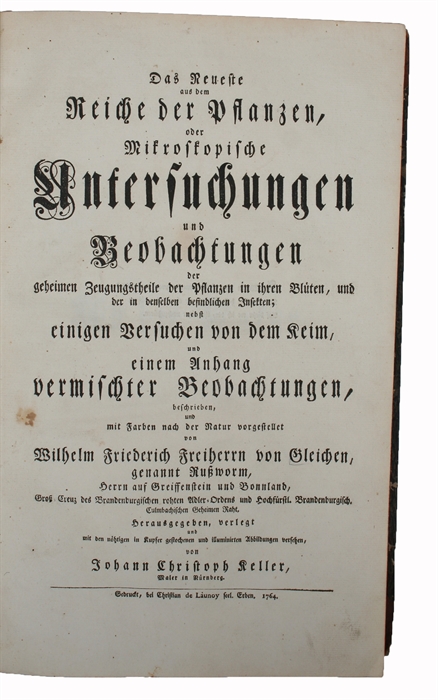GLEICHEN'S MICROSCOPE
GLEICHEN, WILHELM FRIEDRICH von [RUSSWORM / GLEICHEN-RUSSWORM / RUSSWURM].
Das Neueste aus dem Reiche der Pflanzen, oder Mikroskopische Untersuchungen und Beobachtungen der geheimen Zeugungstheile der Pflanzen in ihren Blüten, und der in denselben befindlichen Insekten; nebst einigen Versuchen von dem Keim, und einen Anhang versichter Beobachtungen , beschrieben, und mit Farben nach der Natur vorgestellet. Herausgegeben, verlegt und mit den nöthigen in Kupfer gestochenen und illuminirten Abbildungen versehen, von Johann Christoph Keller, Maler in Nürnburg. [3 parts].
[Nuremberg], Christian de Launoy seel. Erben, 1764 [recte: 1763-66].
Folio. Contemporary half calf with gilt lines to spine. Corners a bit bumped. In magnificent, completely clean and fresh condition. (6), 8, (4), 72, 40, (8), 26 ff. + 51 magnificent engraved plates - all plates in astonishing, contemporary hand-colouring. Plates numbered as thus: 1-5 + 2b (i.e. 6 plates - depiting the microscope), I-XXX + A-E (i.e. 35 - details of floral structure and pollens), Anhang 1-10 (i.e. 10 - mainly insects). The plates are engraved by (and coloured by/under the auspices of) Christoph Keller after drawings by Gleichen-Russworm. With several beautiful, large engraved vignettes (by Johann Michael Stock, efter Keller).
The scarce first edition of this splendid work, in which the outstanding microscopist Baron Gleichen-Russworm recorded his observations of plants and insects. The 51 astonishingly beautiful hand-coloured copperplates show the morphology of plants and insects in great detail as well as his magnificent specially constructed microscope and its different parts, making it of the utmost importance to the history of the microscope as well as the fertilization processes in plants.
With his thorough study of the pollen, stamens, and pistils as well as the process connected with them, magnificently presented in great detail on beautifully produced plates, the work became a great source of inspiration for many biologists and microscopists of the 18th century. The microscope described and depicted here was frequently reproduced from the detailed plates and Gleichen-Russworm's experiments widely repeated in order to investigate the true nature of the plant. The plates depicting the microscope are among the most frequently reproduced depictions of microscopes.
The work appeared in three fascicles, between 1763 and 1766 and were issued with a title-page stating 1764.
Wilhelm Friedrich von Gleichen, known as Russworm (1717 - 1783) belongs to the outstanding microscopists of the eighteenth century. He was the elder son of Heinrich von Gleichen and Caroline von Russworm. "He received little formal education and in 1734, after some years as a page at the court of Prince Thurn und Taxis in Frankfurt, he decided to make his career in the forces of the margrave of Bayreuth. [...]. Gleichen-Russworm remained in the army until 1756, when he resigned his commission in order to devote himself to the management of the Greifenstein estates, inherited from his mother in 1748. His first published writings appeared after his departure from Bayreuth, in the periodical "Fränkische Sammlung aus der Naturlehre, Arzneigelahrtheit, Ökonomie und der damit verbundenen Wissenschaften"; they deal, inter alia, with natural history, physics, and chemistry but are, for the most part, quite fanciful.
[...] In the summer of 1760 Gleichen-Russworm made the acquaintance of Martin Ledermüller, who had already begun publication of his "Mikroskopische Gemüths- und Augenergötzungen" (1759-1762); it was this work which led Gleichen-Russworm to concentrate on microscopy. Ledermüller visited Schloss Greifenstein in 1762, and Gleichen-Russworm continued to benefit from his advice until the former took offense at certain criticisms of his work which appeared in "Geschichte der gemeinen Stubenfliege" (1764).
Gleichen-Russworm was particularly interested in the processes of fertilization in plants and animals, and in 1763 he published the first fascicle of Das neueste aus dem Reiche der Pflanzen. This work contains fifty-one colored plates illustrating numerous details of floral structure and various pollens; in addition, his interest in the construction of the microscope is reflected in the six plates devoted to the different modifications and accessories which he designed for the instrument. His account of the pollen of Asclepias syriaca L. in Auserlesene mikroskopische Entdeckungen (1777-1781) contains what appears to be the first observation of a pollen tube, although he remained unaware of its significance." (D.S.B.).
Nissen BBI: 716. Pritzel: 3367 (merely stating 46 plates). Honeyman: 1515. Wellcome: III:125 (merely having an incomplete copy of the French translation).
Order-nr.: 48272







